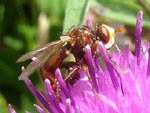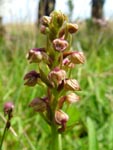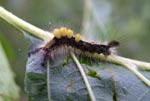Well, the year is almost over. And what a year. I've learned more about wildlife in the past 24 months than I have in the past 48 years.
The photography is relatively easy. A good digital camera with macro and auto-focus makes things so much easier. All you need is a knowledge of where to look, a good eye for a picture and a bit of luck.
The difficulty arrives when you're back at the computer trying to make sense of what you've got. (Is this in focus? Does it show the relevant features? Have I shown it before? What is it, anyway??)
That last question is the biggest question of all. Identifications can easily take up to 10 times as long as the time taken to get the photographs and to build the pages. That's where a network of experts comes into play. I am fortunate to have made contacts with a number of experts who can give me identifications (as far as they can from photographs). This is compounded by the fact that some species look different depending on location, and also due to hybridisation taking place. In addition, many species can only be separated by expert microscopic analysis which is currently beyond my skill, expertise or equipment.
In terms of new discoveries this year, I have made the following: -
The first Irish record for Suillus flavidus - a mushroom found previously only in Scotland.
First county record for Leccinum holopus - a mushroom recorded only once before in Ireland.
First confirmed county record for The Vapourer, a moth.
10k square record for Green Hairstreak, a butterfly.
10k square record for Thelotrema lepadinum, a lichen.
Some things I found out this year: -
-
I've known about parasitic wasps, e.g. Ichneumons, for some time. They parasitise the larvae of other insects by laying their eggs on, in or near them. I photographed probably 30 or 40 different species this year. (It's very difficult to know for certain, because they differ from each other in microscopic detail).
 What
I didn't realise was that some flies are parasitic on 'higher order'
insects such as wasps and bees. I'd always assumed that the more
sophisticated insect would parasitise the lower level one. I stumbled
across a fly - Sicus
ferrugineus, pictured right - on August 10th that catches bumble-bees
in flight and 'staples' an egg upwards into the soft abdomen. Some
hoverflies also lay their eggs in wasps' nests, although there appears
to be no damage to the wasp larvae - the hoverfly larva eats waste
products. In this case, the hoverfly needs to be sufficiently
wasp-like in order to penetrate the nest safely.
What
I didn't realise was that some flies are parasitic on 'higher order'
insects such as wasps and bees. I'd always assumed that the more
sophisticated insect would parasitise the lower level one. I stumbled
across a fly - Sicus
ferrugineus, pictured right - on August 10th that catches bumble-bees
in flight and 'staples' an egg upwards into the soft abdomen. Some
hoverflies also lay their eggs in wasps' nests, although there appears
to be no damage to the wasp larvae - the hoverfly larva eats waste
products. In this case, the hoverfly needs to be sufficiently
wasp-like in order to penetrate the nest safely.
-
Genetic analysis has shown that the Frog Orchid (left) is more genetically
 similar
to the rest of the Dactylorhizas than they are to each other. It might
well be a common ancestor to them all (although visually it is very
different from them). Historically, species were categorised into
families by similarity of these visual clues. Now a reclassification
will take place, based on genetic sequencing. We will then have (at
least) three names for each species: The current Latin name, a common
name and a genetic identifier. Things were difficult enough already.
similar
to the rest of the Dactylorhizas than they are to each other. It might
well be a common ancestor to them all (although visually it is very
different from them). Historically, species were categorised into
families by similarity of these visual clues. Now a reclassification
will take place, based on genetic sequencing. We will then have (at
least) three names for each species: The current Latin name, a common
name and a genetic identifier. Things were difficult enough already.
-
The Vapourer moth has a flightless female.
 Since
species tend to spread based on the mobility of the female, such moths
must spread very slowly indeed (i.e. at the walking pace of the female
or the larva). The Vapourer moth larva that I photographed this year
was in a remote area, so they must have bred close-by. That means
they've been here for a while, but not recorded.
Since
species tend to spread based on the mobility of the female, such moths
must spread very slowly indeed (i.e. at the walking pace of the female
or the larva). The Vapourer moth larva that I photographed this year
was in a remote area, so they must have bred close-by. That means
they've been here for a while, but not recorded.
-
Species populations are very fragile. I've always suspected this, but around five plant species that I recorded in 2003 were/are not present in the same locations this year. That factor is offset by the appearance of a few others on last year's patch, so we clearly have a very volatile situation.
Tomorrow I'll wrap up 2004 and look ahead to 2005.